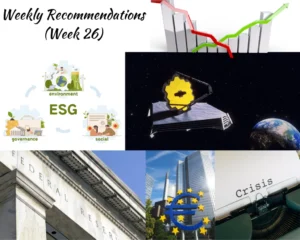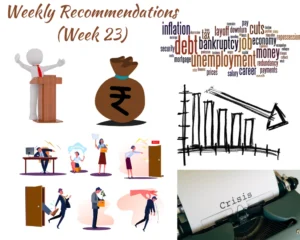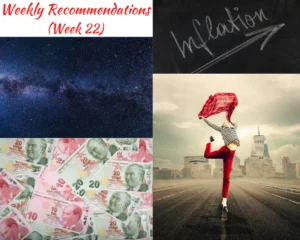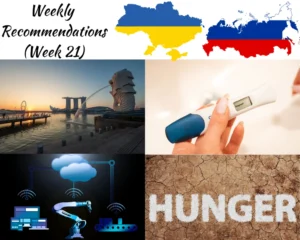This is the twenty-sixth edition of weekly recommendations. Watch this space for facts, news, trivia and research around the world. Topics range from economics, public policy and psychology to finance, society and current affairs. Access all weekly recommendations here.

James Webb Telescope and an Enquiry into the Space
We all have seen the photos NASA released last week that were captured by the James Webb Telescope. The photos were mystic, beautiful and deep. If you haven’t seen them yet, have a look at their Instagram page:
This is a space telescope. It is located in space and is sending us all the photos and information about outer space. Webb telescope is going to be millions of miles away from the earth – four times further from the moon.
I recommend listening to the ‘Unexplainable’ podcast by Vox on this topic. In the latest episode (Website Link, Spotify Link), the hosts discuss – how this telescope is better than the previous version called Hubble, what information astronomers are seeking through this telescope, can it tell us something about the creation of the universe and what are the future types of telescopes that we may be able to see.
One intriguing fact about it is that since it is going to be millions of miles away, we will not be able to fix it if there’s any issue with it later. Another interesting thing about the project is that anyone can use this telescope. You have to submit an application to NASA and then if it gets accepted you may use it.
How the telescope works?
Brian, the co-host says, “Imagine a star that’s really far away. And the light from that star to get to us has to travel through space. But that space itself is expanding and that space is stretching the light until eventually, it gets so red it actually drops into the infrared. And what that means is because Webb collects infrared light, it can see things that Hubble just couldn’t see. Things that are so far away that the light that started off in the visible spectrum is now infrared.”
Can we see the past?
The Hubble could see back more than 13 billion years. But that’s nothing (as per the scientists). Through Webb, they want to go back further.
Someone in the episode said, “If you look at something that’s really far away, the light from it is really old. So something that’s 100 light years away. The light from it has been travelling for 100 years. And so with the Webb, like scientists, are anxious to kind of push this as far as they can, like they want to know how far back can they go and what mysterious things can they see when they go there.”
Astronauts are looking for different answers.
Lisa Dang, a PhD student at McGill University has been awarded time on the Webb to study an exoplanet. Exoplanets revolve around stars that are not our sun. Scientists have found many exoplanets but don’t know much about them. Lisa wants to study such an exoplanet called K2-141b – the lava planet.
Caitlin Casey, an astronomer at the University of Texas at Austin is looking for the Cosmic Dawn. She says, “We are looking for the first light that turned on at the very beginning of cosmic time and its impact on its surroundings. We can’t see all the way back to the Big Bang just yet. But the universe went through a few phases to get to today.”
The episode ends with Caitlin’s dialogue which is – Humans trying to understand the universe is really the universe trying to understand itself.
Everything is damn exciting. Without giving in much, I would like you to head on to the podcast right away.
Get the transcript of the episode here.
Fed and EU Drop Forward Guidance – But Markets Chipper Lately
Central banks provide forward guidance to the public at large about the future trajectory of monetary policy (read as interest rates or quantitative easing). US Federal Reserve did not give any such guidance in its June monetary policy meeting. ECB, this week, abandoned it. Both the central banks have raised their policy rates recently due to rising inflation.
An expert says, “It [forward guidance] was a tool central banks used when inflation was very low, basically to say ‘we will keep rates low for a long time’ to encourage consumers to keep spending.”
This means that from now onwards, formulating investing strategies will get more difficult. The forward guidance helped in avoiding surprise announcements and measures by the central banks that kept financial markets less volatile. Now, that psychological cushion is lost.
However, over the last few weeks financial markets, especially equity markets have been cheerful.
The Financial Advisor magazine reports, “The best explanation for the synchronous rally is that markets, like us, do not believe a severe U.S. recession is likely even if policy tightens a bit more from here. A slowdown in economic growth is inevitable at this point, but strong private sector balance sheets and surprisingly persistent hiring growth should prevent a steep rise in unemployment.”
The Indian scenario could be a bit different. What do you think can happen to Indian financial markets? How will you manage or rebalance your portfolio? Share your thoughts in the comments below.
E for ESG and E for Excited
Capital Group published an annual ESG global study in May 2022. Read the full survey here.
Jessica Ground, global head of ESG at Capital Group, decodes the report for us. Read the analysis here.
ESG stands for Environment, Social and Governance aspects of corporates. She highlights that the growing awareness of climate change has dominated investors’ ESG focus. At the same time, the Russia-Ukraine conflict has put investors’ attention to the governance aspect while the pandemic had already made many socially conscious.
63% of the people surveyed felt that the ESG is not just a passing fad, but will remain one of the important criteria for investments. When asked how much per cent of your ESG focus will be on each aspect, the environmental aspect got more responses at 47%, followed by governance (27%) and then, social (25%).
More than 25% of the investors have already made ESG the central theme of their strategies while only 10% are still unconvinced with the ESG. In 2021, 13% of the respondents seemed unconvinced. So, there’s some improvement in the approach.
She highlights that many investors vary in the inconsistencies and inaccuracies in the ESG data. The No. 1 challenge global investors cited in implementing ESG investments is a lack of consistency between different ESG rating providers (25%).
She concludes, “Results from our global study show that momentum behind ESG and sustainability continues to build. Despite challenges around data, it appears that investors’ awareness of ESG topics is not just increasing, it is also broadening to cover a wider range of social and governance issues.”
– Swapnil Karkare











